Sharks Among Us #4 – The Salmon Shark
This is a Salmon Shark (Lamna ditropis) that washed up dead on a beach in Carrot Park in Port Hardy, B.C. on November 23rd, 2011.
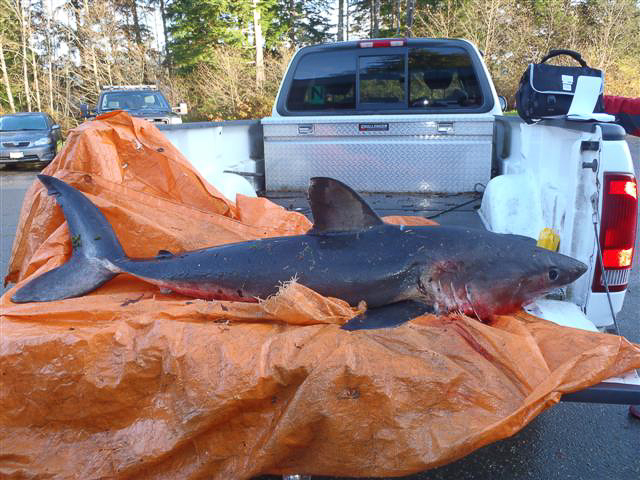
Salmon Shark found dead on Port Hardy beach on November 23, 2011. Photo: Mandy Ludlow.
Local Department of Fisheries and Oceans staff conducted an external examination and collected the unfortunate shark so that a full necropsy could be done at a later date. Although salmon sharks are common in the North Pacific, examining the body may allow science to find out more about the species and how this individual died.
The dead Salmon Shark was just over 1.5 metres (length from the nose to fork in the tail = fork length). The species can be 3.7 m and weigh up to 454 kg.
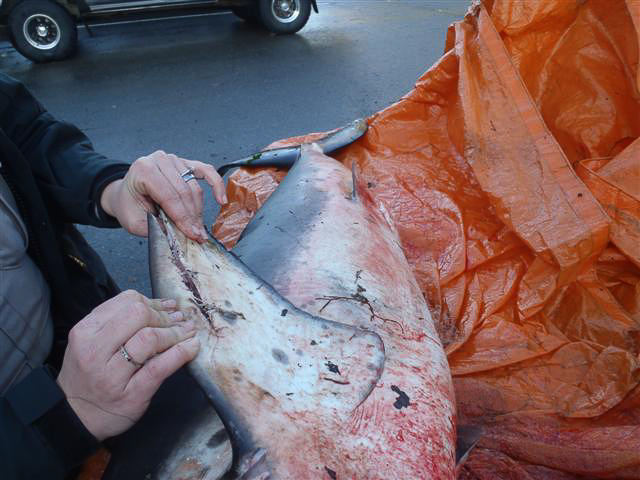
Cut in the pectoral fin suggesting the shark died as a result of by-catch in the longline fishery. Photo: Mandy Ludlow.
Salmon Sharks are of no threat to humans, however, the species does suffer impacts from humanity.
The Port Hardy Salmon Shark had external injuries that suggest it may have been caught in a fishing net and possibly even shot. It had a large cut on its tongue and on one of its pectoral fins and there was a circular hole behind the dorsal fin. Many shark species suffer the threat of by-catch in nets since they are targeting the same species we humans are fishing for.
If it is determined that this shark indeed was caught in a net, this may be particularly interesting since I believe there are no openings for net fisheries at this time of year.
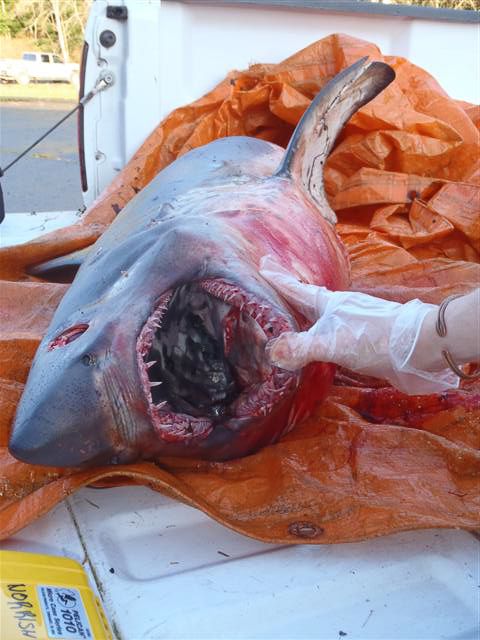
Cut also found on the shark’s tongue. Photo: Mandy Ludlow.
Although Salmon Sharks feed on many species of fish, they are indeed a very successful predator of salmon.
Salmon Sharks can regulate their body temperatures to be higher than the temperature of the surrounding water. The Salmon Shark, in fact, has a higher body temperature than any other shark species. Apparently, even when the water is 2° C, their internal temperature can be 16° C.
This ability to thermoregulate is why, in part, Salmon Sharks can be incredibly fast. The US Navy has recorded speeds of up to 80 km/hr.
I was heartened by the response of the majority of people to the death of this shark. It seems society might be moving beyond the “Jaws Effect” where we demonized sharks because we have bought into their fictitious portrayal.
Many of us now seem to embrace shark fact rather than fiction, realizing that sharks pose little threat to humans; that they have been shaped by some 200 million years of evolution; that globally they are struggling to survive; and that they have an essential role in marine ecosystems.
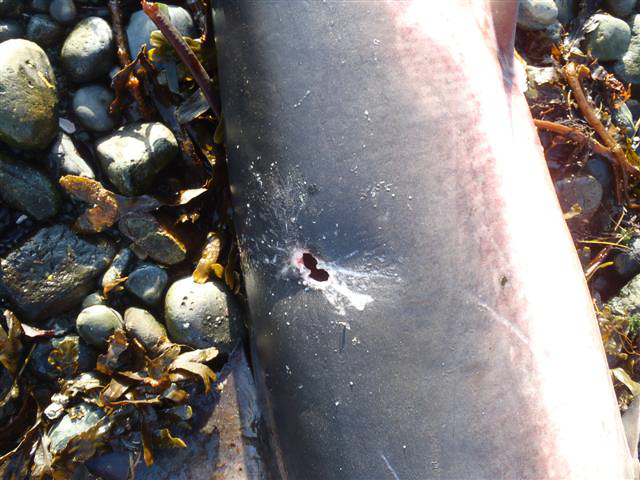
Hole behind the dorsal fin. Photo: Mandy Ludlow.
Sharks, as top-level predators, strongly shape food webs. Loss of such predators has proven to have profound effects on the number and diversity of other species.
The unenlightened are still out there though. It may be an inevitability that sharks get caught in fishing nets but they need not then be shot or butchered. Locally, I have seen evidence of both.
[Update: December 22nd, 2011 – The necropsy revealed that this was a female shark. It is also now known that the shark was caught in a hook and line sable fish fishery and that the hole behind the dorsal was the result of a hook. It is rare that there is shark bycatch in this type of non-net fishery.]
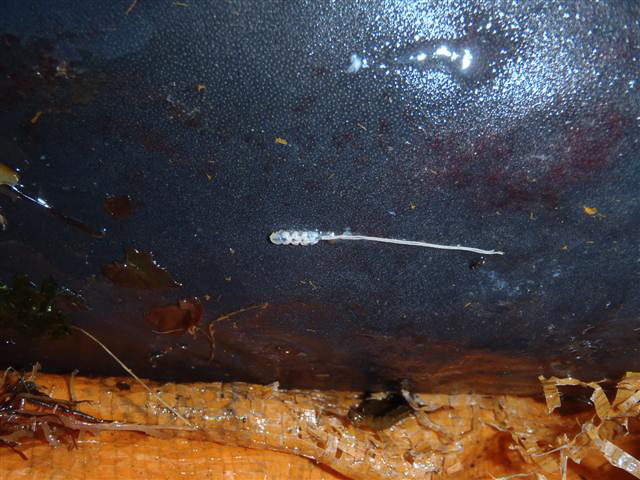
Skin parasite (ectoparasite). I have no expertise here but had suggested that this a copepod from the Caligidae family.
For further information on Salmon Sharks, please refer to the natural history information from ARKive below.
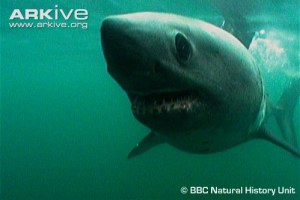
Salmon shark image from ARKive site. Click image for two ARKive videos of salmon sharks hunting. Credit: BBC Natural History Unit.
Salmon Shark Information
from ARKive
Description
A formidable hunter, the salmon shark (Lamna ditropis) is sometimes mistaken for the white shark (Carcharodon carcharias), but can be distinguished by its shorter snout and the dusky blotches that mark the white abdomen of adults (3) (4). The rest of the salmon shark’s stocky, spindle-shaped body is dark bluish-grey or blackish, with white blotches around the base of the pectoral fins. The first dorsal fin is large, while the second dorsal and anal fins are tiny and are able to pivot. Its crescent-shaped tail gives it impressive propulsion through the water (2) (3), while its large, well-developed eyes enable it to spot potential prey (2), and its large, blade-like teeth are well suited to gripping slippery fish(2) (3).
Range
The salmon shark occurs in the North Pacific Ocean. From Japan, North Korea, South Korea and the Pacific coast of Russia, its distribution extends east to the Pacific coast of the U.S.A., Canada, and probably Mexico (3). See this species on Google Earth.
Habitat
The salmon shark is a coastal and oceanic shark, inhabiting waters between 2.5 and 24 degrees Celsius, generally from the surface down to depths around 152 metres, although one individual has been recorded at 255 metres (3).
Biology
Occurring singly or in schools of several individuals (3), salmon sharks are long distance, high-speed predators (2), occasionally seen at or near the surface in some areas. They can maintain their body temperature well above that of the surrounding cold water of the North Pacific, and may have the highest body temperature of any shark (3). This allows them to maintain warm swimming muscles and internal organs, so they can still hunt effectively in cool waters (2).
The salmon shark is considered to be one of the main predators of the Pacific salmon, and its voracious feeding on this fish has earned it its common name (3). However, it is an opportunistic feeder that consumes a wide variety of fish that also includes (amongst many others) herring, sardines, pollock, Alaska cod, lanternfishes and mackerel. It also feeds on some squid and is sometimes attracted to by-catch dumped back into the ocean by shrimp trawlers (3).
After spending the summer in the north of their range, the salmon shark migrates south to breed. In the western North Pacific they migrate to Japanese waters whereas in the eastern North Pacific, the salmon shark breeds off the coast of Oregon and California, USA. The young are born in spring after a gestation period of around nine months (3). The salmon shark is ovoviviparous (young hatch inside the female; they are nourished by their yolk sac and then ‘born’ live), and oophagy (when the growing embryos eat unfertilized eggs to gain nutrients) has been recorded in this shark (4). Most litters contain between two and five young. Male salmon sharks are thought to mature at about five years and live to at least 27 years; females reach maturity at eight to ten years and are known to live to at least 20 years (3).
Threats
The salmon shark is often caught as by-catch in Japanese, United States and Canadian fisheries. When caught, often just the fins are taken for shark fin soup and the rest is discarded, although sometimes the flesh may be sold for consumption in Japan and the United States (4). Many fishermen view salmon sharks as pests, as they often damage fishing gear, making them more likely to be killed if captured (4). In addition to the threat of by-catch, some recreational fishing for this shark occurs in Alaskan and Canadian waters (4), and some commercial fishing has taken place in the past, such as in Prince William Sound, Alaska (5).
Conservation
In 1997, the Alaska Board of Fisheries closed all commercial shark fishing in state waters and implemented strict regulations in the state sports fishery for salmon sharks (4). Measures such as these are vital in protecting this species’ future, until further research can determine the conservation status of this magnificent predator.
Additional information:
Click here for two ARKIve videos showing Salmon Sharks hunting.
Click here for the petition to ban shark fin products in Canada and here for video by astounding 18-year-old Madison Stewart about the vilification of sharks and the atrocities of shark-finning . . . 73 million sharks killed/year for their fins = 190 sharks killed/minute.